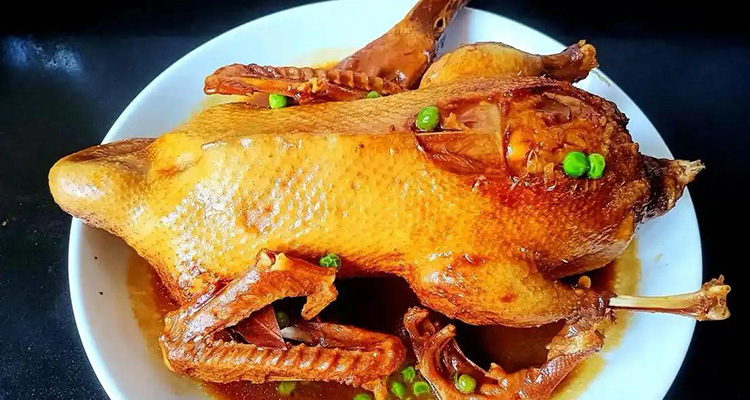Shanghai Eight-Treasure Duck: A Culinary Tradition
Shanghai’s Eight-Treasure Duck (Ba Bao Ya) is a celebrated local specialty and a classic dish for Lunar New Year dinners. The whole duck is carefully deboned and stuffed with eight prized ingredients—glutinous rice, lotus seeds, Jinhua ham, diced chicken, winter bamboo shoots, chestnuts, shiitake mushrooms, and ginkgo nuts—then slow-steamed until tender. The finished dish appears plump and glossy; the meat falls apart, while the stuffing is soft, fragrant, and deeply savory. When the duck belly is opened, a burst of aroma emerges as the flavors of all ingredients meld together—a memorable sensory moment.
1. A Storied Origin
Eight-Treasure Duck traces back to imperial and Jiangnan culinary traditions and evolved in Shanghai from a Suzhou dish. Chefs in old Shanghai replaced chicken with richer, fattier duck and refined the filling, creating a signature “haipai” (Shanghai-style) classic. By the 20th century, famous old restaurants made this dish an elite banquet favorite; later it gained national recognition as a signature Chinese dish.
2. Symbolism and Celebration
Beyond flavor, Eight-Treasure Duck carries deep cultural meaning. The eight ingredients symbolize good fortune, prosperity, and family reunion. Lotus seeds signify fertility, ginkgo evokes wealth, and glutinous rice represents togetherness. For Shanghai families, unveiling and sharing the duck at New Year or weddings is a ritual of unity and blessing.
3. Carefully Selected Ingredients
Authentic Eight-Treasure Duck depends on ingredient quality: a 1.5–2 kg plump duck with rich subcutaneous fat; glutinous rice soaked in advance; Jinhua ham for umami; peeled lotus seeds; fresh winter bamboo shoots; seasonal chestnuts; thick shiitake mushrooms; and full ginkgo nuts. Chefs often add chicken cubes, dried scallops, or shrimp for extra depth, and season with light and dark soy, Shaoxing wine, and a touch of sugar.
4. Skilled Preparation
Making a true Eight-Treasure Duck is a culinary art. The most demanding step is deboning the whole duck while keeping the skin intact. The cooked stuffing is packed into the duck, which is sewn closed, blanched, then steamed for several hours until the meat is tender but the shape remains. Some restaurants finish with a brief roast to caramelize the skin for color and texture.
5. A Layered Tasting Experience
A well-made Eight-Treasure Duck achieves both an intact, elegant presentation and a treasure-filled interior. When sliced open, the fragrant steam releases duck fat, rice, and ham aromas. The duck meat should be tender and nearly fall-off-the-bone; the stuffing richly infused with duck essence. Textures—chewy glutinous rice, soft chestnut, tender mushroom, and savory ham—balance in harmonious layers.
6. Rituals for Eating
Traditionally, the host or elder slices open the duck at the table, presenting the filling first for communal tasting, then serving the meat. Pair the dish with plain steamed rice to soak up juices, or wrap slices in thin pancakes. A simple stir-fried vegetable and a pot of green tea (such as Longjing) help refresh the palate.
7. Where to Try It in Shanghai
For the most authentic experience, visit historic Shanghai restaurants and old haipai eateries—places like Shanghai Old Restaurant and Green Wave Pavilion (Lübo Lang) are renowned for traditional techniques and require advance booking. Michelin and modern interpretations appear at upscale venues such as Yongfu and Fook—expect reservations and seasonal pricing. A whole Eight-Treasure Duck typically serves 3–4 people and ranges in price depending on restaurant and ingredients.
8. Practical Tips for Travelers
The best season to enjoy Eight-Treasure Duck is autumn and winter, when ducks are fattier and chestnuts are fresh. Reserve 1–2 days ahead as preparation is time-consuming. Many classic restaurants in areas near City God Temple (Chenghuang Miao) offer this specialty—combine your meal with local sightseeing. Learning a few Chinese phrases (“Ba Bao Ya” and “yù dìng” for reservation) makes ordering easier. Don’t forget to photograph the dramatic moment when the duck belly is opened.
9. Simplified Home Version for Curious Cooks
At home, try a pared-down version: use boneless duck or deboned duck breast, and fill with cooked glutinous rice, diced ham, shiitake, chestnuts, and seasoned minced pork. Seal with skewers or kitchen twine, brush with soy-honey glaze, and roast at 170°C (340°F) for about 2 hours, covered with foil, then finish at higher heat for crisping. It won’t fully match the restaurant complexity but offers a rewarding taste of the tradition.
Eight-Treasure Duck is more than a dish—it’s a living piece of Shanghai’s culinary heritage, blending technique, symbolism, and shared celebration. Add this fragrant, ritual-rich entrée to your Shanghai itinerary and savor a quintessential taste of the city.


